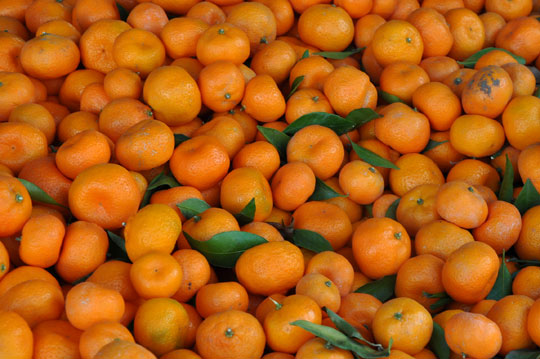by Sophia Bosselmann
For Valentine’s Day last month, my parents sent me care packages. My mother sent chocolate and baking implements as she knows my sweet hobby. My father sent me a package filled with kishus.
A kishu is petite, round, and bright orange, resembling and tasting much like a tangerine but sweeter. Its proper name is Citrus Kinokuni Mukakukishu. Kishus descended from Ruju, an ancient mandarin variety found during the Tang Dynasty. They were popularly grown in Japan, and in the 1980s took a trip to America where they were bred by the University of California for mass production, and have since become a California gem. I fell in love with them last summer, while working at a Chez Panisse in California.
There, in the chilly walk in, I first encountered this tiny bright orange globe. After taking the boxes of citrus out of the walk in, and carrying them upstairs, I began my task: to find 300 perfect kishus. I had been instructed on what to look for and how to sort through them. Lifting up my first box of kishus, I pulled open the cover to reveal their bright orange shining faces. I picked one up and held it to the light for inspection: I looked for scratches, bumps, bruises, any trace of mold discoloring— most notably white spots, which change the taste slightly—or anything else that would make the kishu in my hand imperfect. The first one had a bruise, the second was too firm, the third had another bruise, and the fourth was just right; I tucked it into a hotel pan I had already set up, the cold metal softened with blue napkins, to prevent the kishus from bumps, bruises, scratches, or woes of discomfort. Only 299 more to go.
To my left was the pastry cook who would not let any imperfect fruits pass onto service. To my right was the pastry chef who performed an extra inspection before arriving to the waiters upstairs, who were the last check the kishus before they arrived at guests’ mouths. Those kishus that are imperfect are sliced in two and then juiced to make kishu sorbet or peeled, pithed, and sectioned for coulee. The sorting process is to be done every day by the pastry intern, who I happened to be for the duration of kishu season. So you could assume under such conditions I would grow tired of the little buggers.
But I love them; I love the scrutiny, the care, and the downright ridiculousness of the sorting process. Because I can trust that these are the best and most loved fruits—the sweetest— and, at least at the restaurant, I knew exactly where they had been grown: Churchill-Brenneis Orchards located in the Ojai Valley in Southern California, my home state. And it is the most fun to say, “Kishu.”
The day I received a very squishy package in the mail, a white box with a brown bag filled with kishus, I grinned ear to ear. I peeled one and pop the whole thing in my mouth. I tasted the sweetest citrus and thought about people surging across the globe, fruit found on one side of the world being popularized in another country, and then made for mass production. As I ate I thought about how kishus embody both my Californian and Asian culture.
Work Cited:
“Kishu Mandarin Information, Recipes and Facts.” Specialty Produce Is San Diego’s Best Wholesale Distributor. Web. 20 Feb. 2012.
“Chez Panisse Cafe Menu.” Chez Panisse. Web. 20 Feb. 2012.
“Churchill Brenneis Orchard.” Churchill Brenneis Orchard. Web. 20 Feb. 2012.
Sophia Bosselmann is a Eugene Lang Senior studying both Global Studies and Creative Writing. She has been working in restaurants since she was eighteen. She currently works at Craft.


Comments are closed.